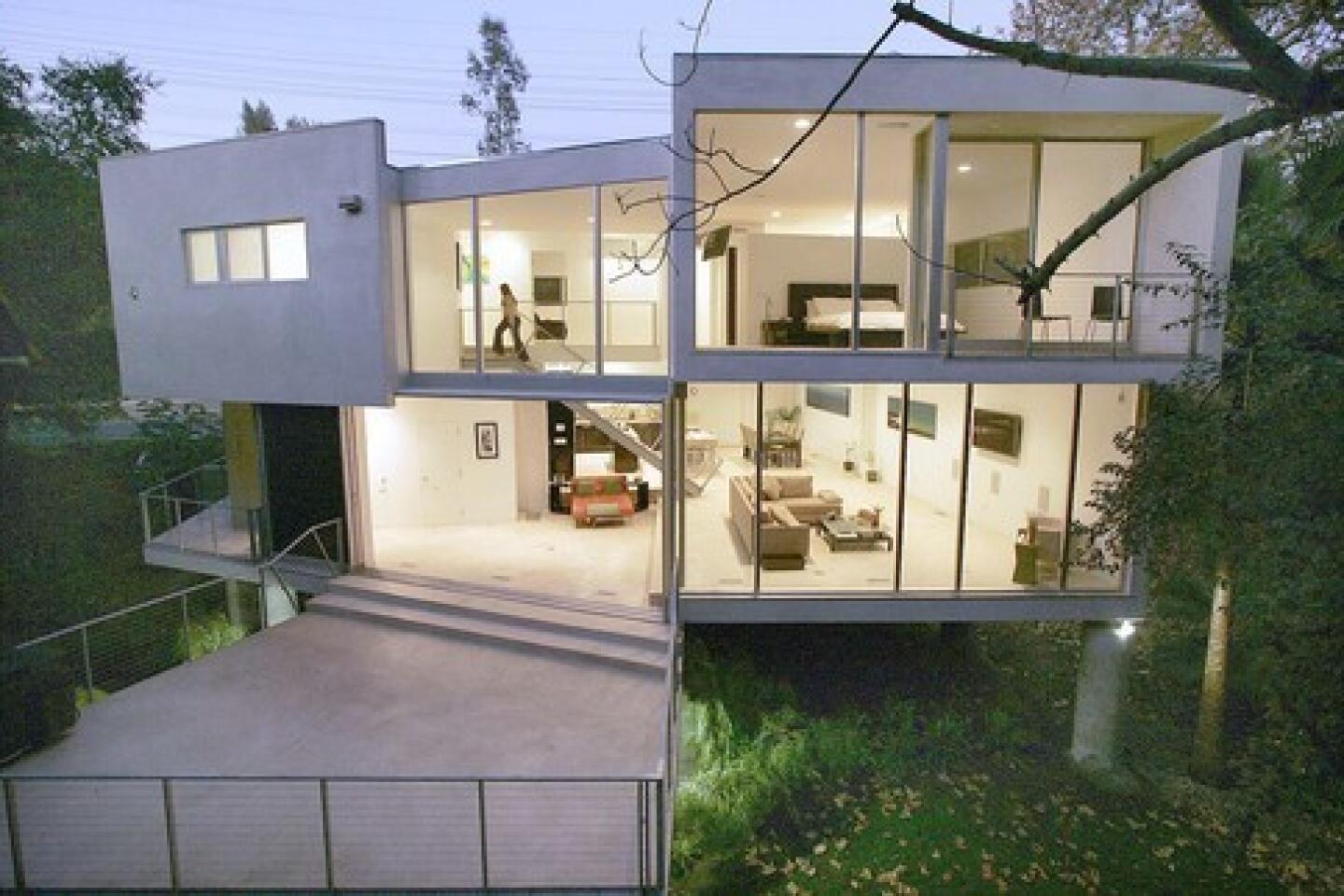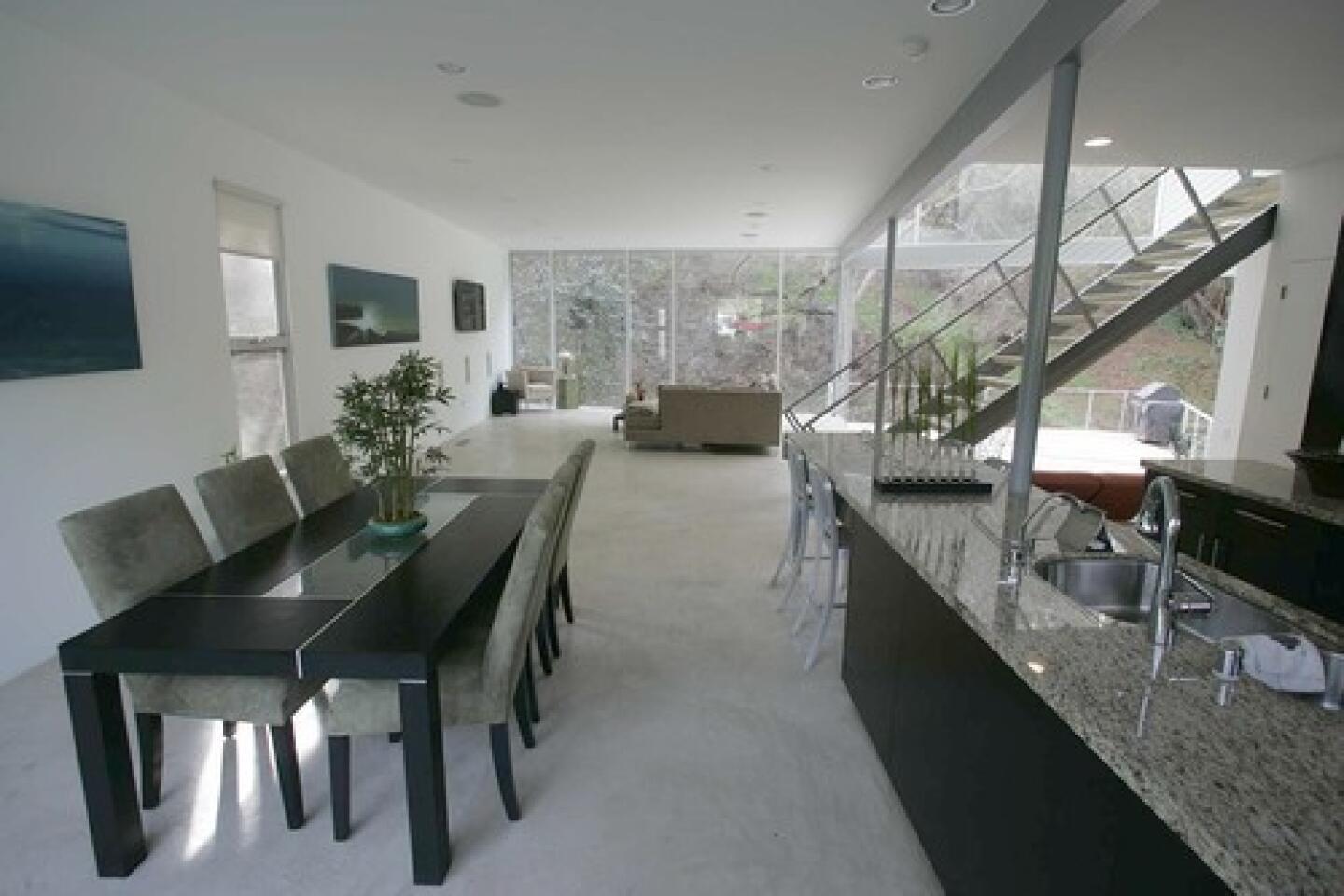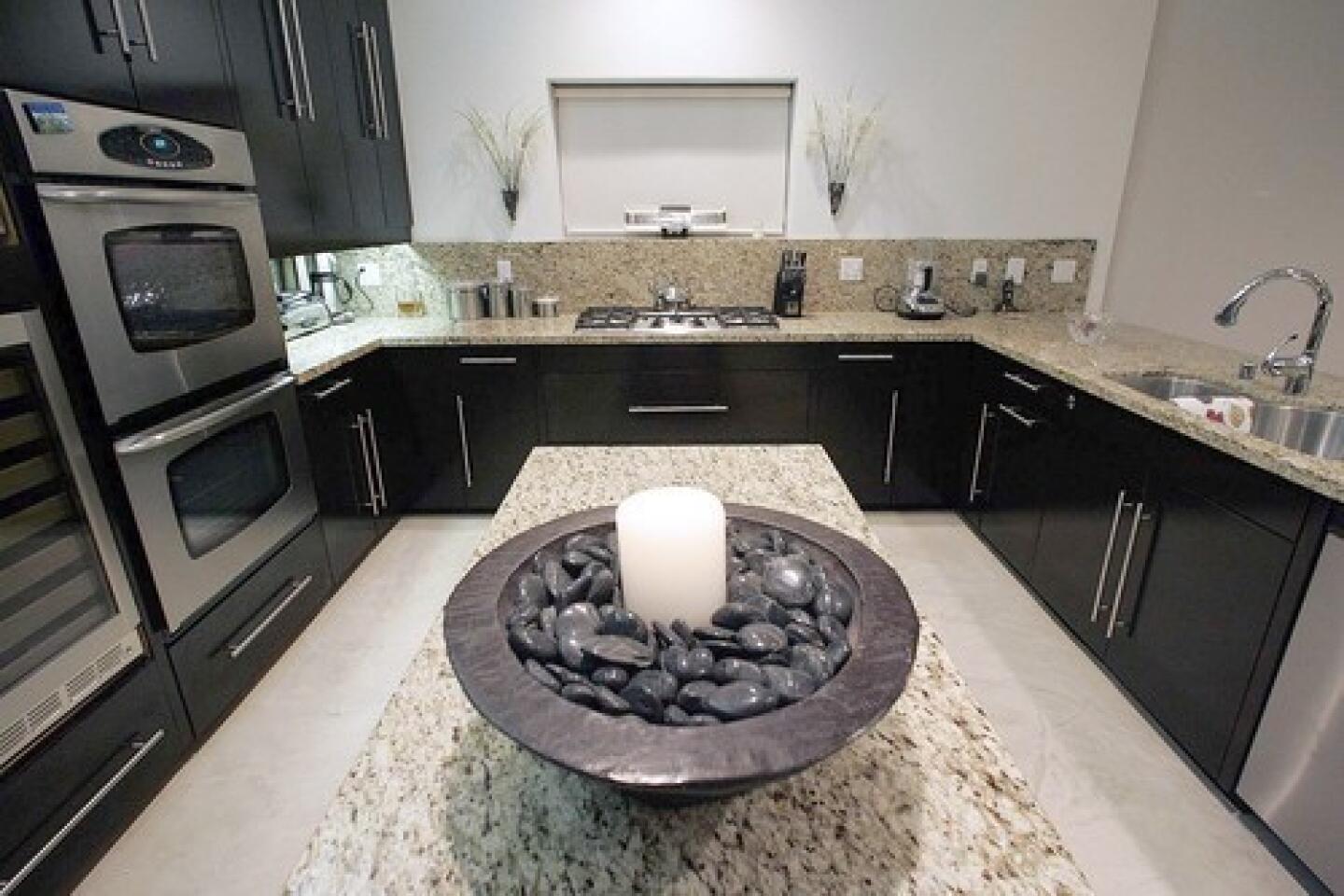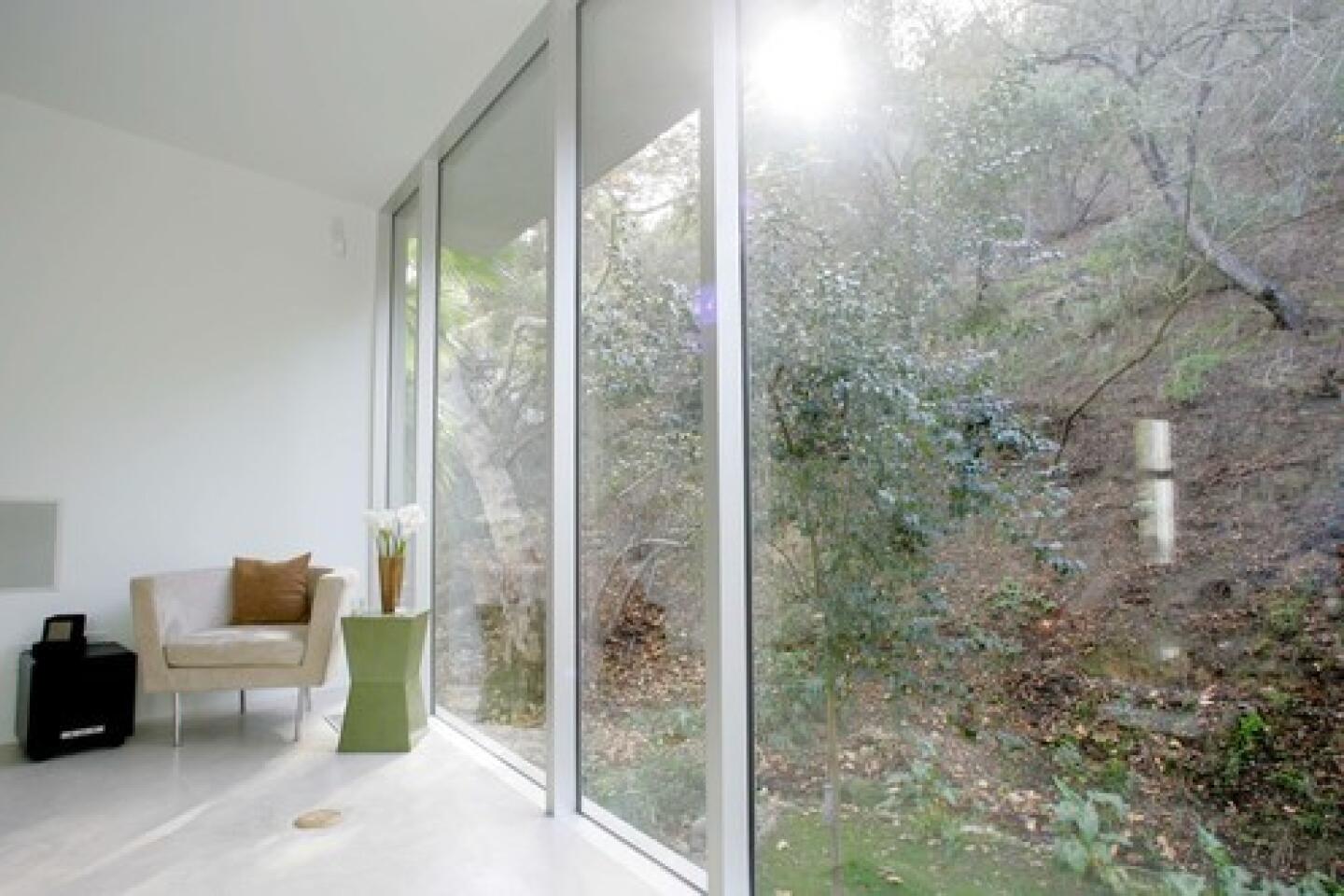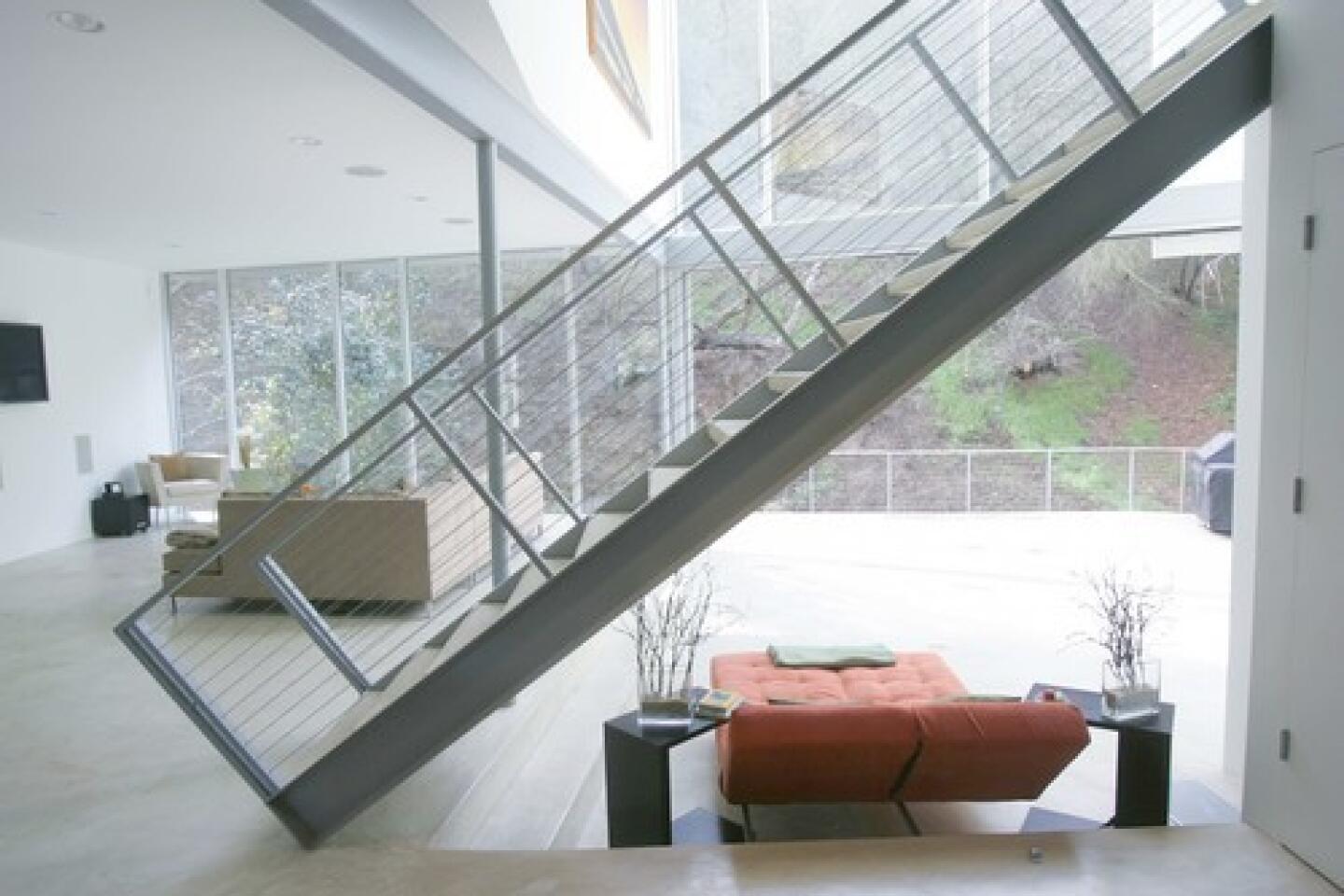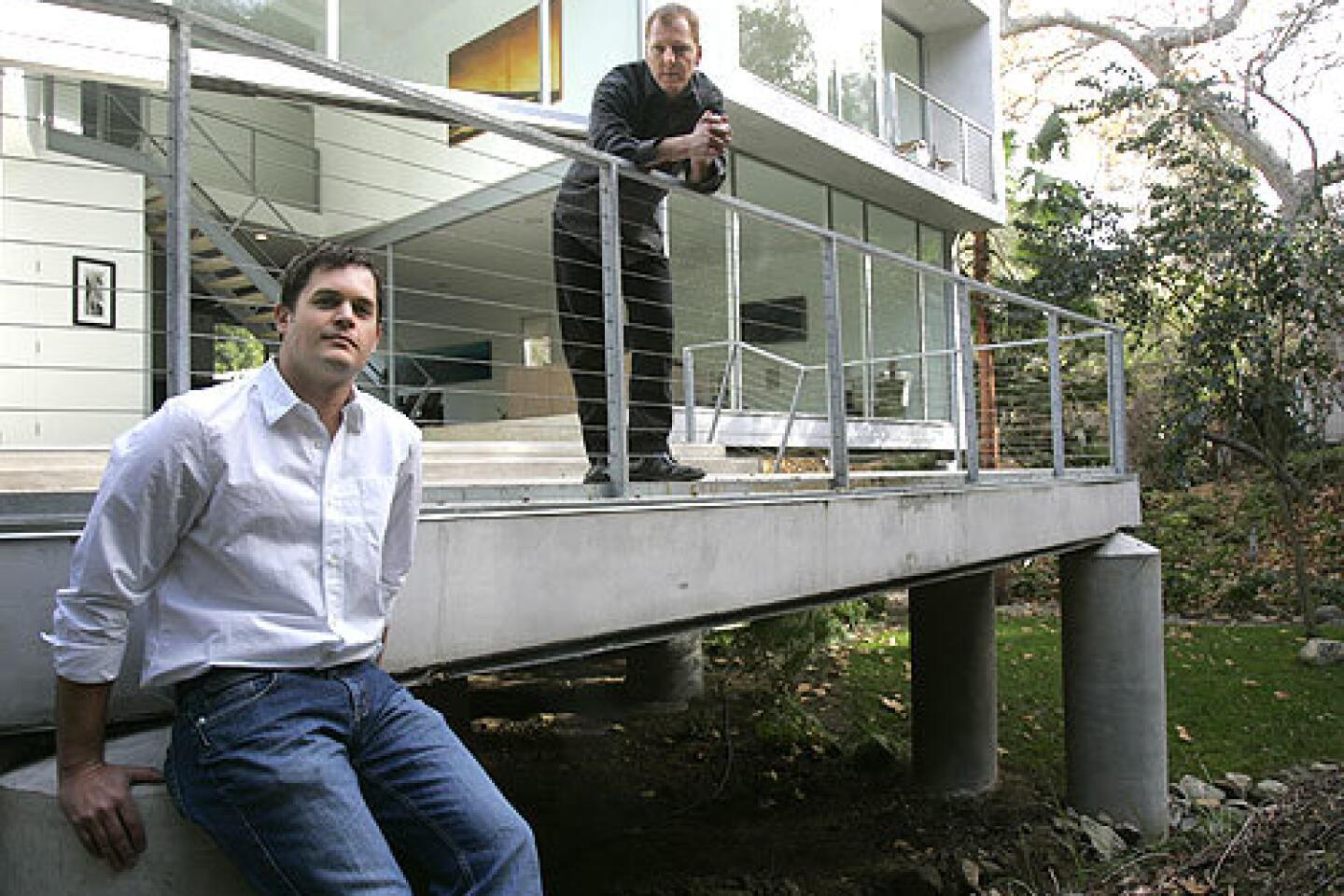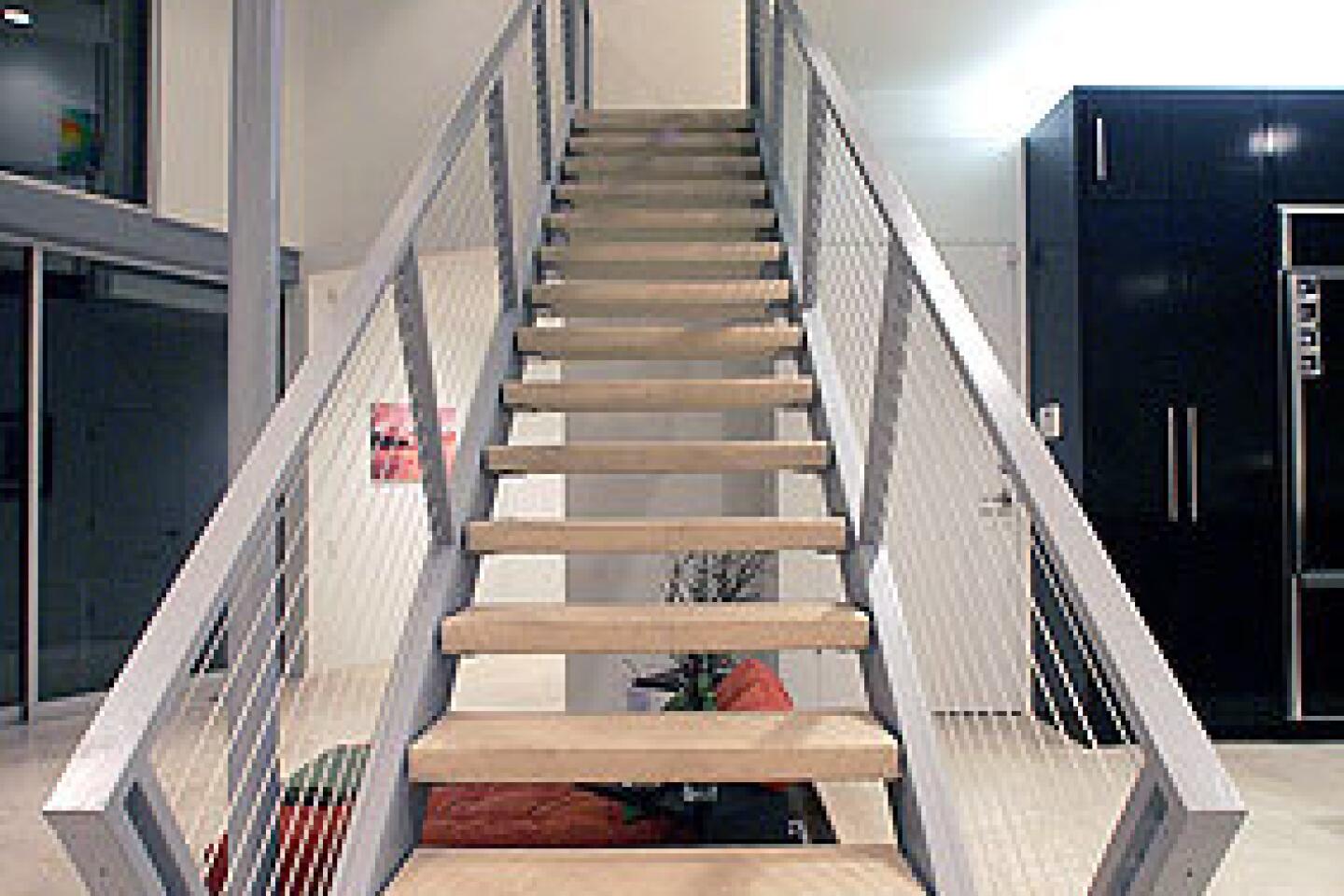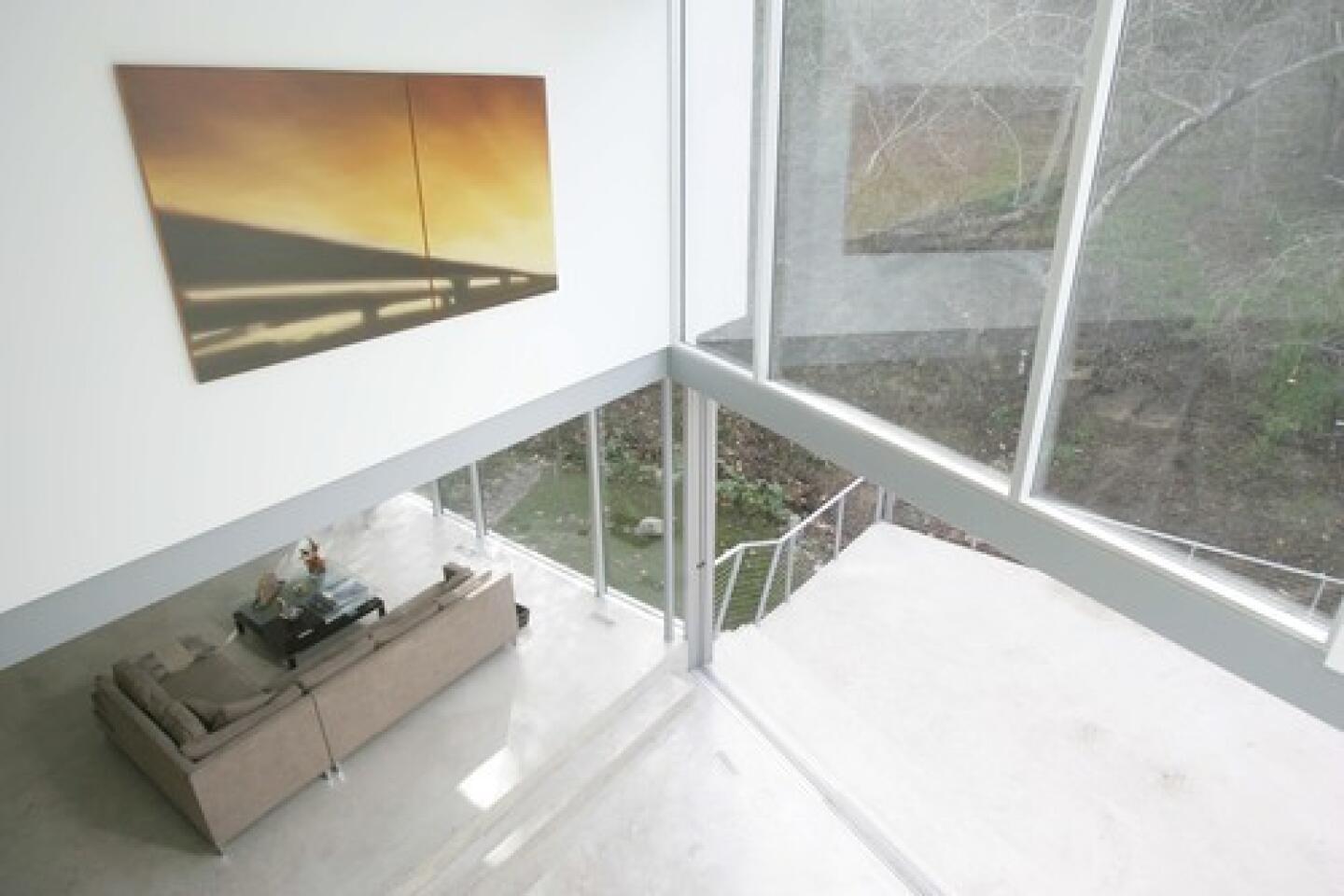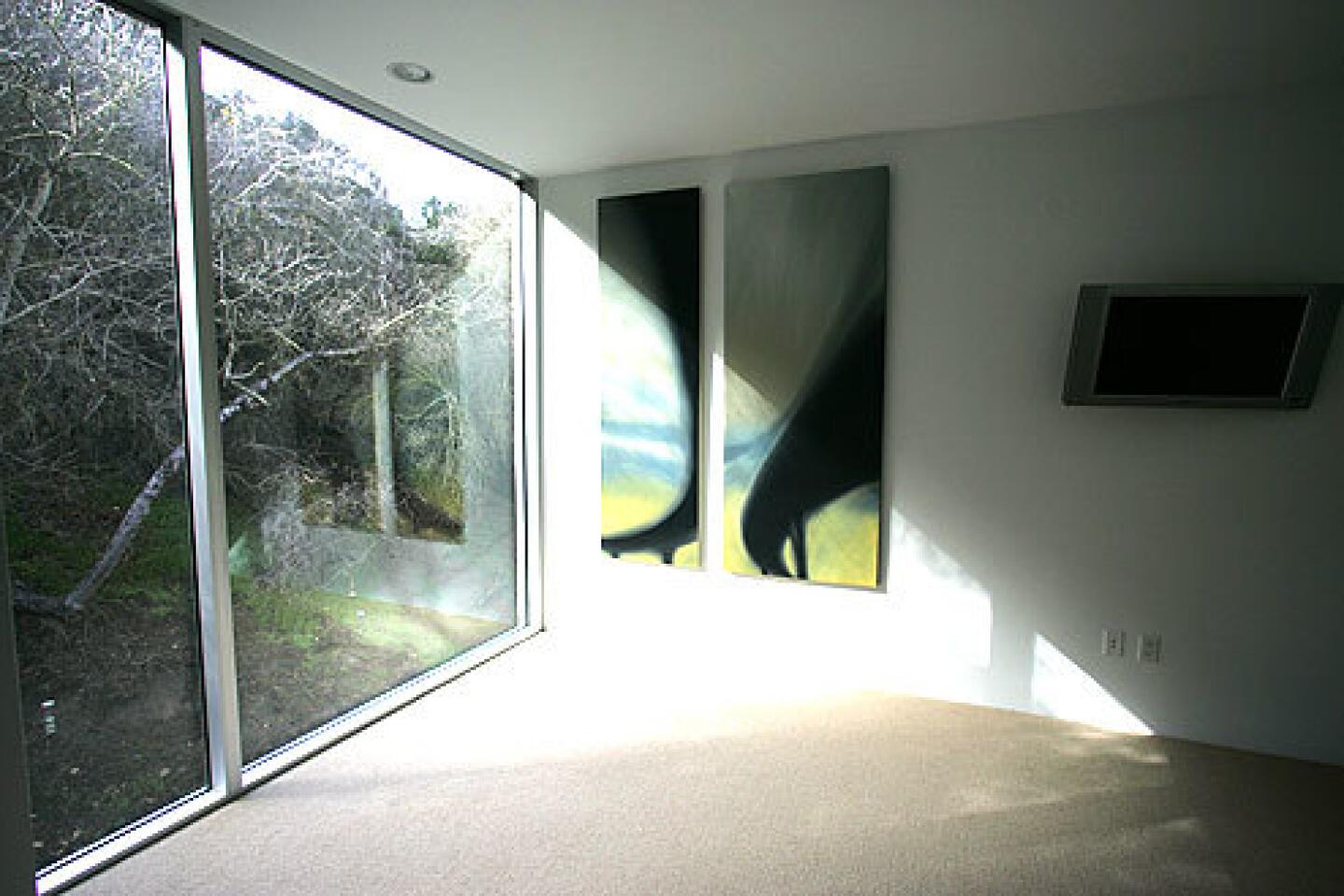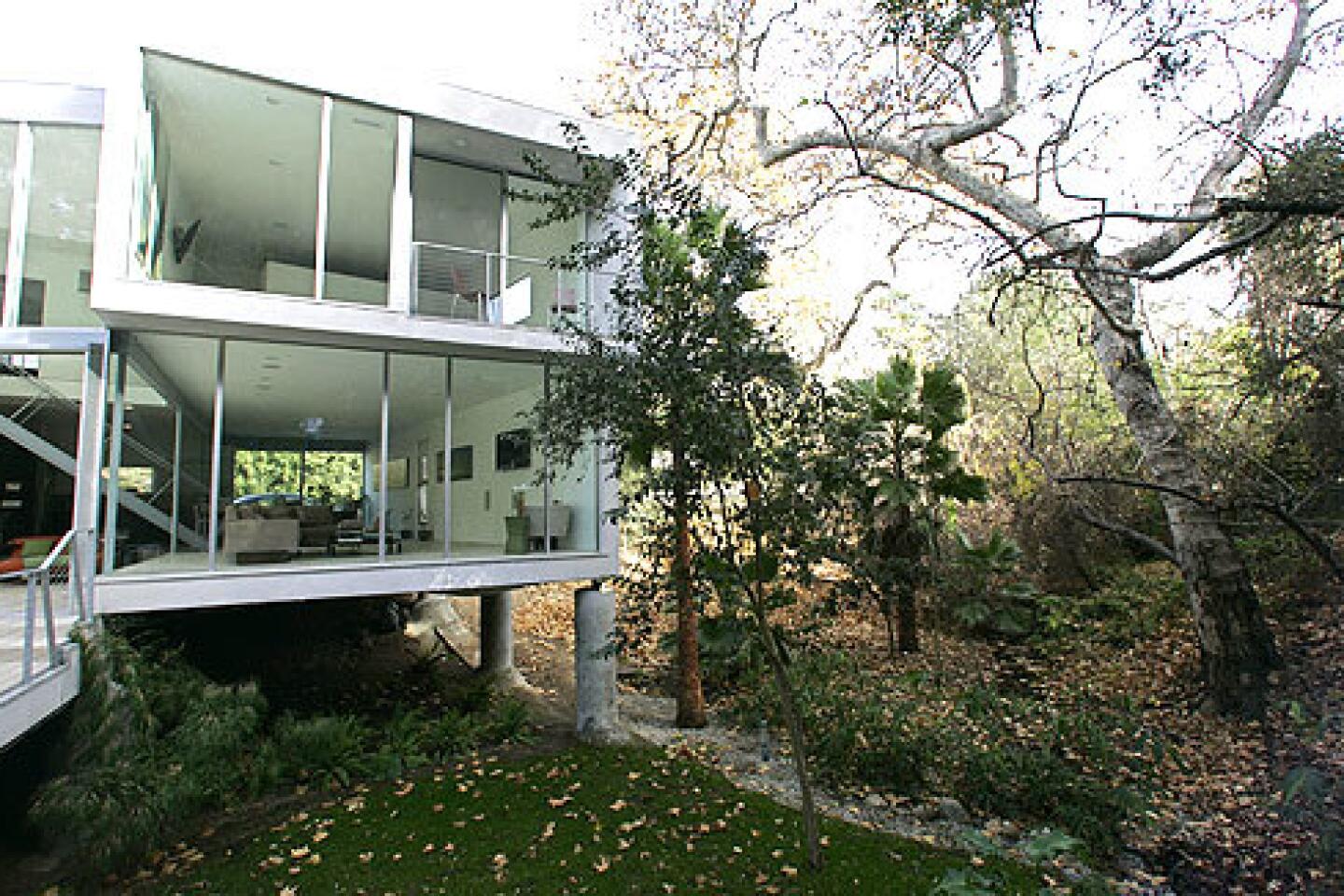Built with wild abandon
When a family friend first suggested to Corrine Glass that she buy the Studio City lot, her response wasn’t “no.”
“I looked at him,” Glass recalls, “and said, ‘You’re absolutely out of your mind.’ ” The parcel had stood vacant for decades, declared unbuildable by previous would-be buyers. Its steep slope made construction an impractical and expensive proposition. A creek ran though the feral landscape.
Then there was the traffic. Stand along this stretch of Laurel Canyon Boulevard, and one hears the soundtrack of a city: the rattle of delivery trucks and the hip-hop bass thumping from SUVs, the staccato squeal of bad brakes and the throttle of motorcycles zigzagging through the morning commute. Horns honk. Sirens wail.
Glass had never built a home before -- or bought one, for that matter -- which perhaps is why she could ponder the daunting hillside, the creek and the estimated 30,000 cars that the city says pass by every day, then go back to the family friend with her answer: sold.
Three years and more than a few panic attacks later, Glass has a finished house that is a realm of peace and quiet. Dual-pane argon windows and beefed up insulation reduce the timbre of traffic, and from her minimalist, open-plan kitchen, dining area and living room, she can admire her other former nemeses, the wooded hill and burbling creek, now defining features of the home. While the city rushes by in front, wilderness beckons from behind.
In some ways, the distinctly modern design represents the future for a region whose patches of vacant land are becoming ever-more scarce and for residents who can afford to live in the metropolitan core. As Southern California grows more dense and as architects and urban planners are forced to redefine what’s “livable,” this house stands as an unlikely success: a measure of calm and solitude in an increasingly frenetic and crowded city.
Perhaps no one is more pleased than Glass, who wakes up each morning in a master bedroom cantilevered into the treetops, a perch from which she can watch resident hawks, coyotes, a deer and her fawn.
“You can stand pressed up against the window, and it feels like you’re in a treehouse,” she says. “I can watch it for hours. It’s just so very peaceful.”
To understand just how much Glass has endured to reach this point, one must rewind to fall 2003 and a post- Yom Kippur gathering where Glass, a lawyer, was approached by a family friend.
He had a vacant lot that had been a thorn in his side, he said. A neighbor had agreed to buy the land but backed out of the deal. The friend wanted to know: Legally, what can I do?
Not much, she said, to which he responded: “You’re young. Why don’t you build on it?”
Glass, who was 27 and renting in Santa Monica at the time, rebuffed the suggestion, but over the next couple of weeks, the offer -- $35,000 and the land was hers -- seemed too good to pass. Two-bedroom condos in her neighborhood were selling for $800,000. Could building a home on the lot be any worse?
“Everybody thought I was out of my mind,” says Glass, who entered an option-to-purchase agreement that allowed her to back out of the sale if construction proved to be impossible or too expensive. “I was taken by how lush the lot was. It was covered with bushes and trees, and it had this nature feel to it.”
She called in architect Aaron Neubert, whose aesthetic was distinctly modern with Japanese influences, precisely what Glass wanted. With promising results from geologists’ soil tests and encouragement from Neubert and his collaborator on the project, architect Mike Jacobs, Glass signed the final papers.
“After I bought the lot,” she says, “my dad called every day for two weeks saying he was having nightmares about me doing this.”
Indeed, it wasn’t long before she had nightmares of her own.
From the outset, budget was a priority. Glass had taken on $160,000 in debt putting herself through law school, and though she had some cash set aside, she was adamant that the design -- four bedrooms and three bathrooms in about 3,000 square feet -- be economical. Though she declined to reveal exact construction costs, similar architect-built homes on comparable parcels in L.A. typically cost $675,000 to $900,000 to construct, excluding furnishings and decor.
While Neubert and Jacobs devised a plan for a modern house nestled at the rear of the lot, high on the hillside with a view of the valley, concrete and steel prices continued to rise. By the time contractors were called in for bids, Glass’ hillside retaining walls were estimated at $250,000.
“I think the estimate for the foundation alone was more than Corrine’s entire construction budget,” Neubert says.
If necessity prompts inspiration, then the architects proved truly inspired. They came back with their Plan B: a two-story stucco box set on the down slope right next to Laurel Canyon, shielding its occupants from traffic and orienting all attention toward the landscape in back.
An entry path gently sloped around the side of the house, a procession intended to physically and psychologically remove residents and visitors from the bustle of the street. The front door opened onto a 29-foot-high landing, which led into the living room, dining area and kitchen, all loft-like, free-flowing and filled with natural light. A steel staircase led up to a game room -- public space linking the downstairs to the second floor. Hallways upstairs led to the master suite and two other bedrooms.
L.A. building codes required the envelope of the house to be set back 15 feet from the street in front and 15 feet from the toe of the hillside in back. To provide more living space and to connect indoors with outdoors, sliding glass panels opened onto a breakaway deck that, in the event of a hill slide, would separate and slip under the house rather than into it. The final footprint was a pork chop shape that maximized every inch.
With this design set, construction began in August 2004. The headaches began soon after.
Crews drilling for 11 caissons hit an unexpected amount of groundwater, which had to be pumped out for the concrete to cure.
Then there was the psychological trauma of watching a neighbor’s house literally fall apart. During the rains of winter 2004-05, parts of Laurel Canyon began to slide, and that January a house a few blocks away tumbled off its foundation and into the street. In one 15-day span, no less than 17 inches of rain fell in L.A., halting construction and widening the cracks in Glass’ confidence.
Rulings by the city didn’t help. It required sprinklers under the house in case of a brush fire. Cost: $5,500. It mandated that the newly constructed driveway and sidewalk be ripped up to accommodate a wheelchair turnaround. Cost: $3,000.
“Then there was the gas line,” she says with a sigh. The city gas hookup was across the street, so if Glass wanted hot water, she had to cut across five lanes of traffic to lay the proper connection. The problem? By coincidence, the city decided to repave Laurel Canyon right before she pulled her permit.
“You can’t cut into the road for 24 months after they have resurfaced it,” Glass says. If she did cut into the road, the city said, she’d have to pay for Laurel Canyon to be repaved yet again. The tab for that: “$251,000, plus a 35% government tax,” she says.
Ultimately, she called City Hall -- “everybody I could.” By literally sobbing her story -- and emphasizing that she never received advance notice of the repaving, as is policy -- Glass got a waiver and her gas line for $33,000.
“At that point, I was running out of time and money and credit,” Glass says, adding that her construction loans were starting to expire. “It was terrifying. My contractor said I was cursed.”
“The thing about building is that you can’t really walk away,” Glass says. “I really had no way out other than figuring out how to fix each issue.”
In this case, the solution was to borrow more money. The hot real estate market allowed Glass to refinance her construction loan, pay off her law school debt and cover the expense of building and furnishing the house -- in the end, 17.5% more than originally budgeted.
A year and a half after breaking ground, however, Plan B stands largely as envisioned: serene, surprisingly quiet and inexorably connected to the land on which it sits. The house is a sculpture unto itself, Glass says -- a 2,900-square-foot white cube, elegantly simple, adorned by the ethereal landscapes of Los Angeles artist Miguel Osuna and one other addition: a husband. Corrine wed Rob Glass last spring and, with construction completed in July, the couple held a reception for 100 people in the new house. “It felt like we could have fit even more,” she says.
Visitors have loved the home. One day the couple was on the deck admiring the foot-wide creek, icy and clear, whisking fallen leaves to parts unknown, then Rob headed back inside.
Honey, he said, there’s a giant cat in the house.
Honey, she responded, that’s not a cat.
Intruding raccoons notwithstanding, this private little wildlife sanctuary has erased any lingering regrets about the original hillside design that never came to be. Besides, the couple is occupied by other thoughts. Within one week of moving in, Glass got pregnant. The baby is due in April.
WHAT serves as a modern home for a young couple also stands as a symbol for the future of single-family homes in L.A. and the challenge architects face in crafting habitable spaces from the region’s scattered vacant lots. Many of these so-called urban in-fill properties have long been considered too difficult, if not impossible, to build on.
“We think of all of L.A. as in-fill,” says Jane Blumenfeld, principal city planner for Los Angeles, whose department has seen space-crunched Angelenos build homes as small as 700 square feet on lots as small as 2,000 square feet.
“You get more creative because the low-hanging fruit is gone. In the ‘50s, people had bean fields and orange groves that were cheap to develop. As time goes on and technology gets better, people are building on lots that in years past no one would ever have thought to live on.”
Almost anything is possible if one’s wallet is deep enough, but these days even the budget-minded have more options, thanks to new machinery and materials. More agile, powerful equipment allows builders to reach neglected sites that were inaccessible in years past. High-tech windows that block noise better are used more widely.
“We have reached a critical point in the city,” says professor Anastasia Loukaitou-Sideris, chairwoman of the urban planning department of UCLA’s School of Public Affairs. “If we don’t want to push out the boundary of where people live, we need to find ways to build on some of these urban lots.”
The demand for more homes, schools and offices in the metropolitan core -- not, say, Moreno Valley or Santa Clarita -- will force innovation, she says. Difficult typography, toxic contamination, noise pollution and neighbors who don’t want new structures in their midst: These are problems whose solutions “are going to define the architecture of the city.”
Stand in the Glasses’ dining room with the shades drawn at midday, and one instantly understands what the professor and city planner are talking about. Noise-blocking glass makes it almost impossible to believe that trucks are doing 50 mph a mere 20 feet away. Though traffic still prevents any real connection with the neighborhood, the design of the house “protects its relationship to the landscape,” Jacobs says. It ultimately celebrates the hillside’s ungroomed beauty and brings a measure of peace to those living inside.
“I hate that street and what it represents,” Neubert says. “It’s very antisocial. It’s a freeway that people happen to build homes on.
“In the end, though, you look at this place and say, ‘Yeah, I could live here.’ ”
The Glasses’ sentiments exactly.
Times staff writer Lisa Boone contributed to this report.
More to Read
Sign up for Essential California
The most important California stories and recommendations in your inbox every morning.
You may occasionally receive promotional content from the Los Angeles Times.
